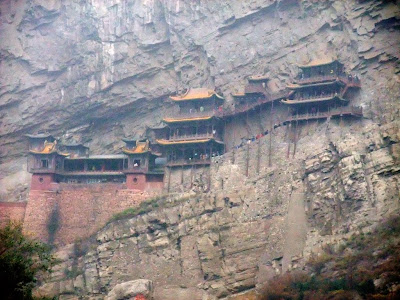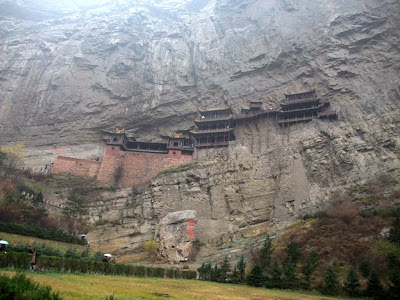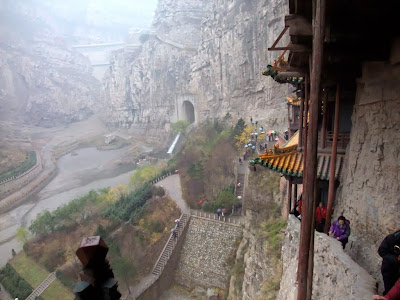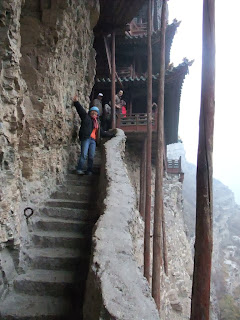
The world famous Hanging Monastery in Datong, Xuankong-si (玄空寺or县空寺) survived for 1500 years is an architectural wonder. Clinging to a crag at the West cliff of Jinlong Gorge opposite Mount Heng-shan (恒山金龙峡), it was built into a cliff more than 50 meter above the ground. The Temple is hold in place with oak cross beams fitting into holes that were chiseled onto the rocky cliff and of course there were also some other hidden support inside the natural rock-bed. Xuankong-si is not only notable for its position on a sheer precipice, it is also the only ancient monastery remained in China that includes three Chinese traditional belief and religion under one roof, with Laozhi, Sakyamuni Buddha and Confucius enshrined together inside a hall. The monastery is a remarkable example in Chinese architecture field that combined the sector of tradition into style, feature with suspension, elegance and uniqueness. It is not surprising at all that Time Magazine classified it as one of the ten most odd and dangerous building in the world.



The construction of the original Xuankong-si Monastery was said to be conducted by a monk named Liao-ran (了然和尚) in Wei Dynasty (386-534). It was conceived in year 491 when the Pulpit of Taoism was moved from Southern Datong City to here. Builders strictly followed the basic principal of Taoism that noises should be kept away from the site including roosters' crowing and dogs' barking. To meet the strict requirement, locating the temple in a small canyon basin hanging from the middle of a rocky cliff under a prominent summit, was the most ideal choice then. And in addition, the cliff could shield the buildings from floods, while mountain peaks and ranges surrounded could protect it from rain, shine and snow.


The Monastery is greatly amazed by visitors of the past and present. The two large red Chinese character 壮观 (read as zhuang-guan) on the rock, which mean spectacular, was written by the famous poet Libai (李白) from Tang Dynasty (618-907) after his visit. The great traveler Xu-xiake (徐霞客) from Ming Dynasty after seeing the monastery, commented that it was an extraordinary unique sight on earth (天下奇观).



The amazing Xuankong-si Monastery is an important historical site and tourist destination in Datong city, attracting crowds of people, local and abroad, to come and inspired the magnificent feat of an architectural wonder.


Jinlong Gorge, where Xuankong-si Monastery stood, lies between Hengshan ranges and Hunyuan Town (浑源县城), 65km away from City of Datong.


The wooden props appear outside are not the main and actual supporting structure of the temple. The artisans took full advantage of the natural rock and applied some mechanical principal theory to construct this strong yet wonderful rare structure with their incredible wisdom. It is indeed a great architectural and cultural achievement of Chinese people.



A truly marvel produced from the wisdom of ancient Chinese that had withstood the winds and storms for nearly 15 centuries.



Extensive repairs, maintenance and extension works were done during Ming and Qing Dynasty (1368-1644-1911) for the monastery, that resulting to the present scale of its scheme.



Some of the pillars that were applied from the bottom to the top are of not much use. The strong foundation and support came from the cross beams that were inserted into the rock and the rock at its back.


The size of the monastery is about 125 sq. meter building with 40 over halls and cabinets at its three major sections. The largest hall only covers a size of 36 sq. meter but the vividly carved 80 sculptures are interesting. They were either made of copper, iron, clay terracotta or stone.


The entrance is opened at the southern end of the temple.



Lets enter and explore into this marvelous architectural achievement of ancient Chinese.



Standing 50 meter above the ground under the rain, facing a deep valley, I was nervous yet exciting......



Following the direction arrows, I entered from the south door to the bell tower and from there climb up to the Main Shrine Hall at 2nd floor. Main Hall enshrines three Buddhist images of Buddha Vairocana (毗卢遮那佛), Amitaba and Sakyamuni at the center with Statue of General Guanyu on the right and Taiyi-Zhen-ren (北极神太乙真人), the northern supreme god of Taoism at the left side.



There are more than 40 halls within the site, linking with intricate numerous passageways from left to right as if a dizzying maze.



Looking down, crowds of people continued to flock in irregardless of the rain. The wet weather never dampened their enthusiasm and interest in this ancient and unique religion site.


Pilgrims cautiously mind their own steps following the crooked veranda pathway to come to its South Hall. The structure has three tiers. Taoist Palace Cunyang-Gong (纯阳宫) at first floor houses the image of Lv-dongbin (吕洞宾) and Chinese folklore tradition Gods for Heaven, Earth and Water were being worshiped at the second floor. Buddhist Leiyin-Dian (雷音殿) enshrined with Buddhist Images is at the top floor.



The intricate ins and outs are quite complicated within its narrow, steep and winding passageways.




Guanyin-Dian that enshrined the image of Goddess of Mercy is at the central layer of Northern Hall which has a total of three floors. The base floor is the shrine hall for Five Buddha and the top floor houses the images of three great philosophers and founder of Chinese belief and religions: Buddhism, Taoism and Confucianism. Enshrined and worship Sakyamuni Buddha, Laozhi and Confucius under one roof inside the same hall is indeed very unusual and rare in the history of China.


The South Hall of the Monastery has three floors.


The rock structure surface.



A scenic view of Jinlong Gorge.



Cuiping-feng (翠屏峰) at Jinlong Gorge is the first lofty dangerous mountain peak before reaching to Hengshan.


A last glimpse of admiration to the wonderful sight. I may not be coming again but the sight will always be in my memory.



I tried to figure out how the monastery appear like a tumbled-down castle when looking up from bottom, as many locals said.



An adventurous and exciting moment has just over.



Mt Hengshan (恒山) located at Hunyuan County is one of the five reputable mountains in China. It represents the Northern Region in the nation while the other represent South, East, West and Central regions. The whole length of Hengshan measured from north east to south west is about 150 meter. Tianfeng-ling (天峰岭) which is 2016 meter above the sea level, is the highest peak within the ranges.



Commencing from West Han Dynasty (206 - 9 BC), Hengshan had found with buildings of temple and in Ming and Qing period (1368-1644-1911), the mountain had covered with multiple temple sites and complexes. Presently, the main temple site of Mt Hengshan is Temple Beiyue-miao (北岳庙), which enshrined with Supreme Mountain God of northern Ranges Beiyue-Dadi (北岳大帝).



Hengshan were notable for its 18 sights in the past but now only few remained at site and Hanging Temple is one of the most famous.


Hengshan, also known as Changshan (常山) or Yuanyue (元岳), is popular for its large numbers of Taoist Temples and Monasteries. The pair of scrolls that used numbering to describe Hengshan, read as "3 monasteries 4 ancestral sites 9 pavilions" and "7 palaces 8 caves 12 temples" (三寺四祠九亭阁; 七宫八洞十二庙). We were not lucky enough to witness such scene as we picked a wrong day to visit when the whole mountain sight was almost wrapped up by heavy fogs.



Zhang-Guolao (张果老) was one of the eight immortals in Chinese mythology. It was said that Hengshan was the hermit-crab of this immortal, where he practiced and cultivated for his path. The Taoists believed that he ascended to heaven from Guolao Range by riding a mule in a reverse way.


An attractive new landmark with an official Tourism Logo of China "Horse Stepping flying swallows", was erected along the road that cut through mountain way towards Hengshan area. "Horse Stepping flying swallows" (马踏飞燕)" was a copper relic from East Han Dynasty (25-220) unearthed from Wuwei Leitai of Ganshu Province in 1969.(I visited the site few years ago, its amazing).



The brief map and introduction of Mt Hengshan.



No comments:
Post a Comment